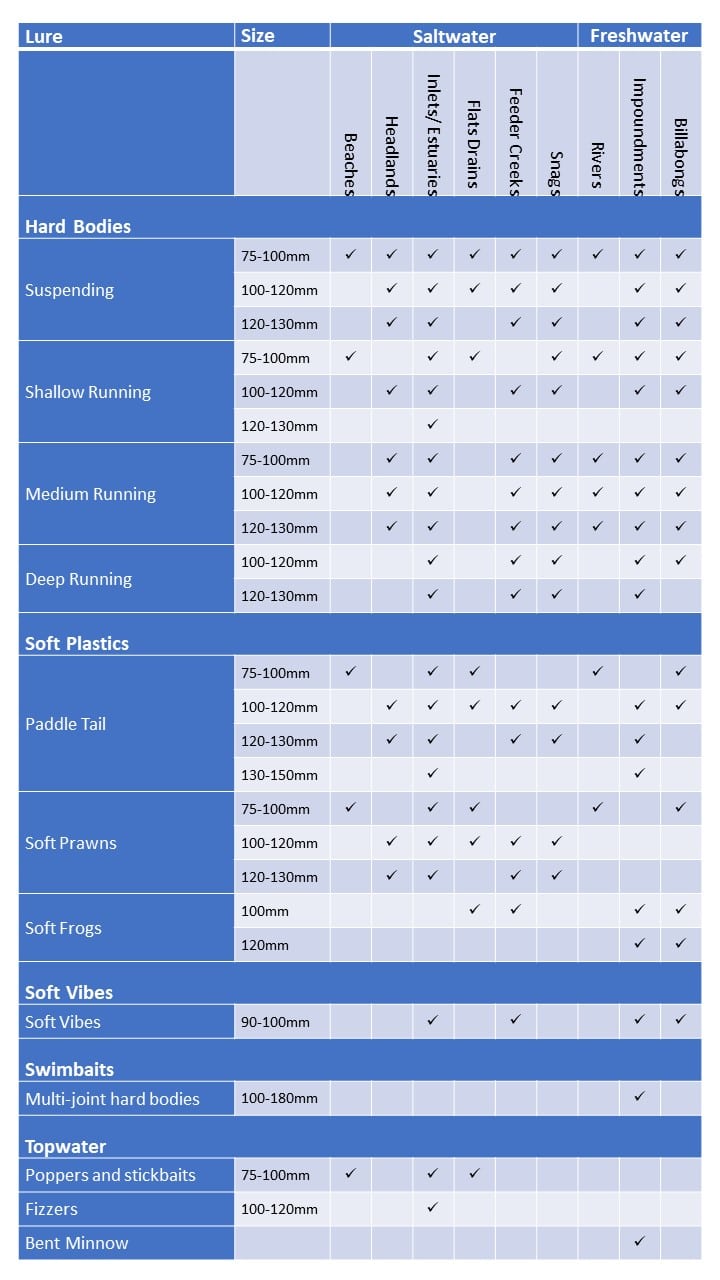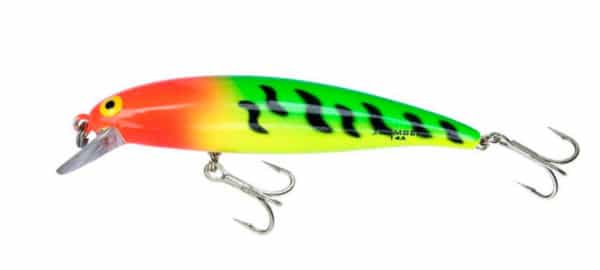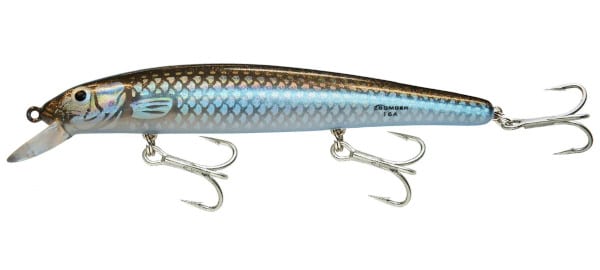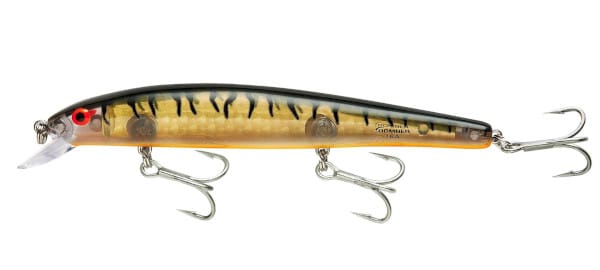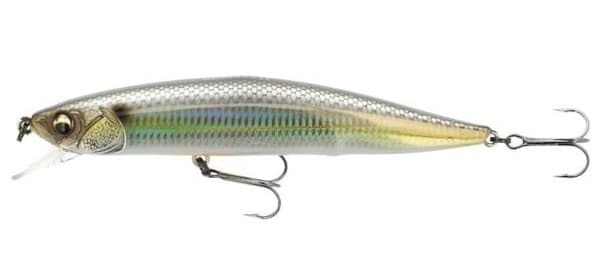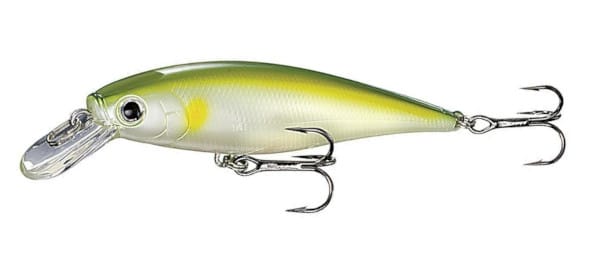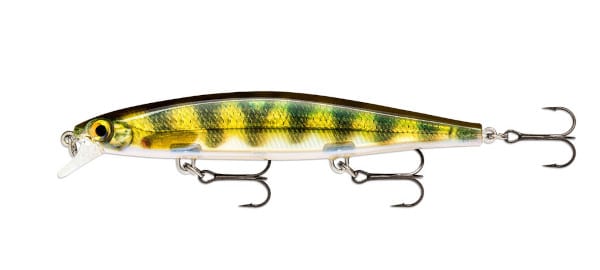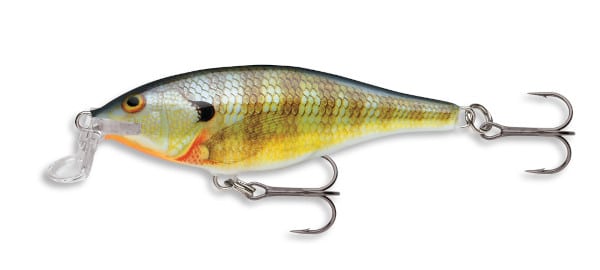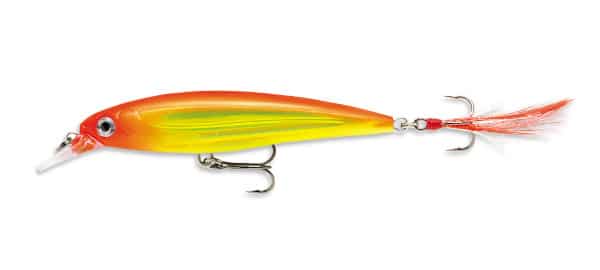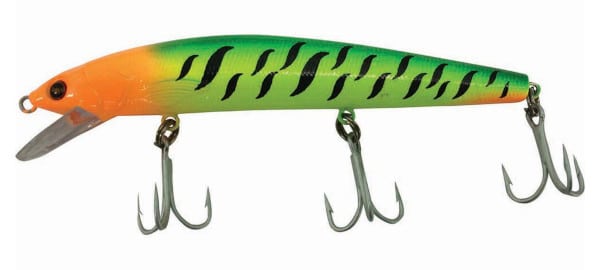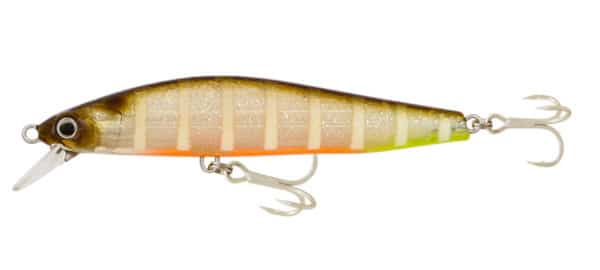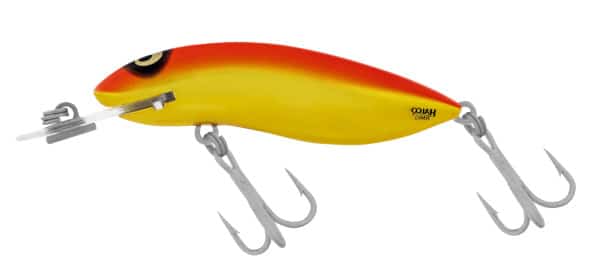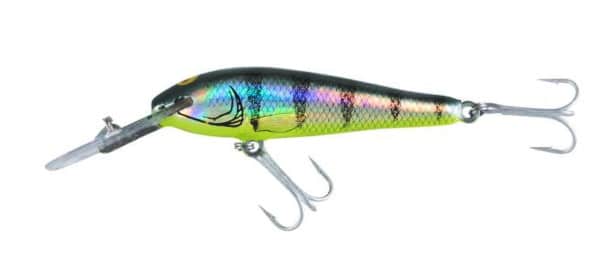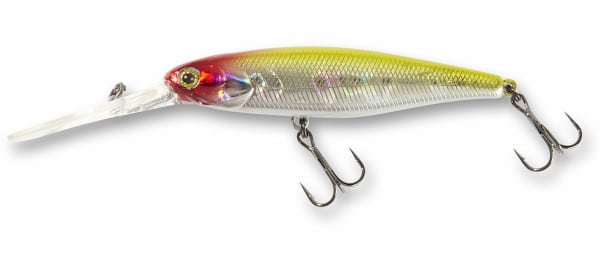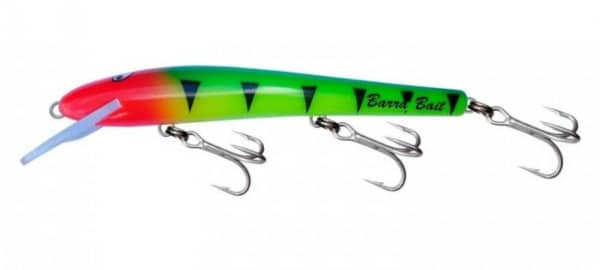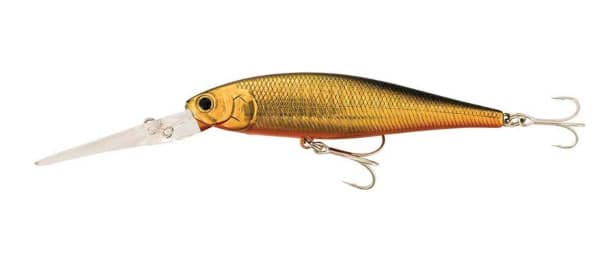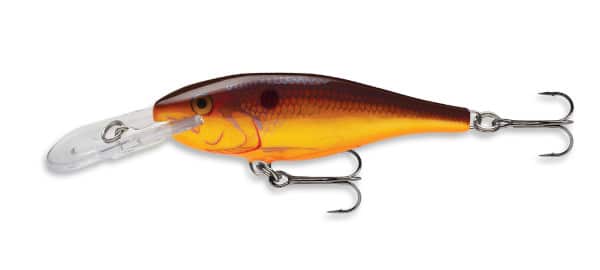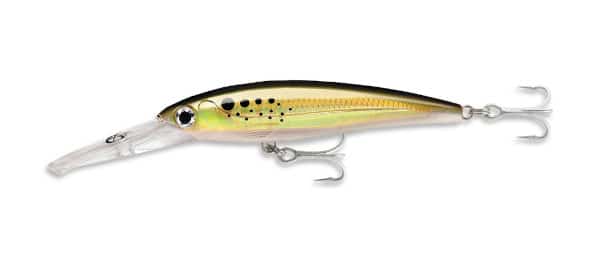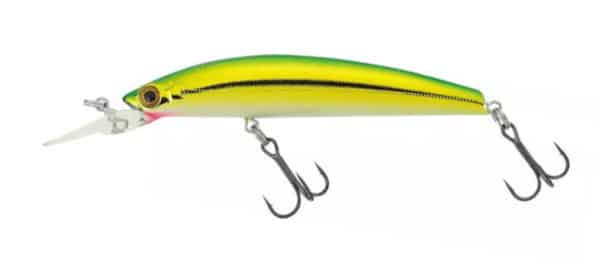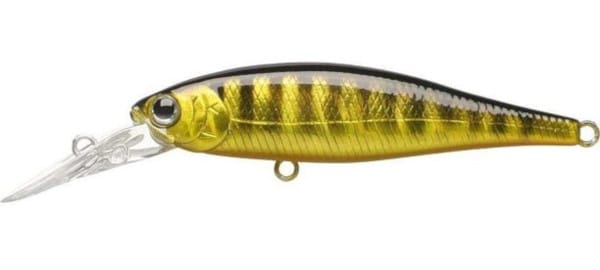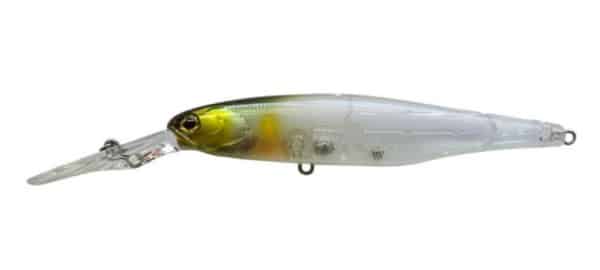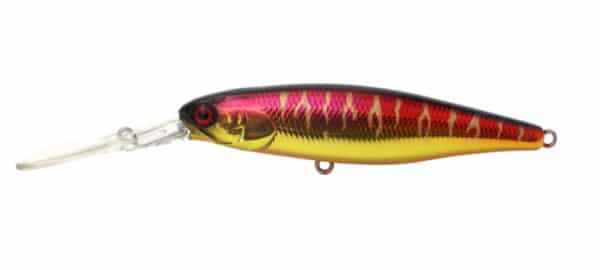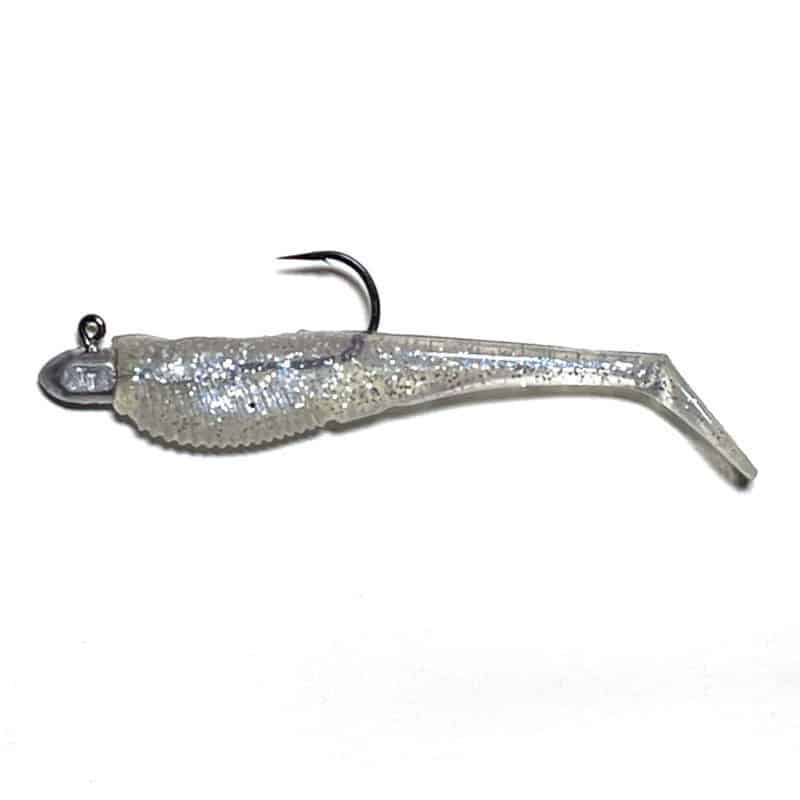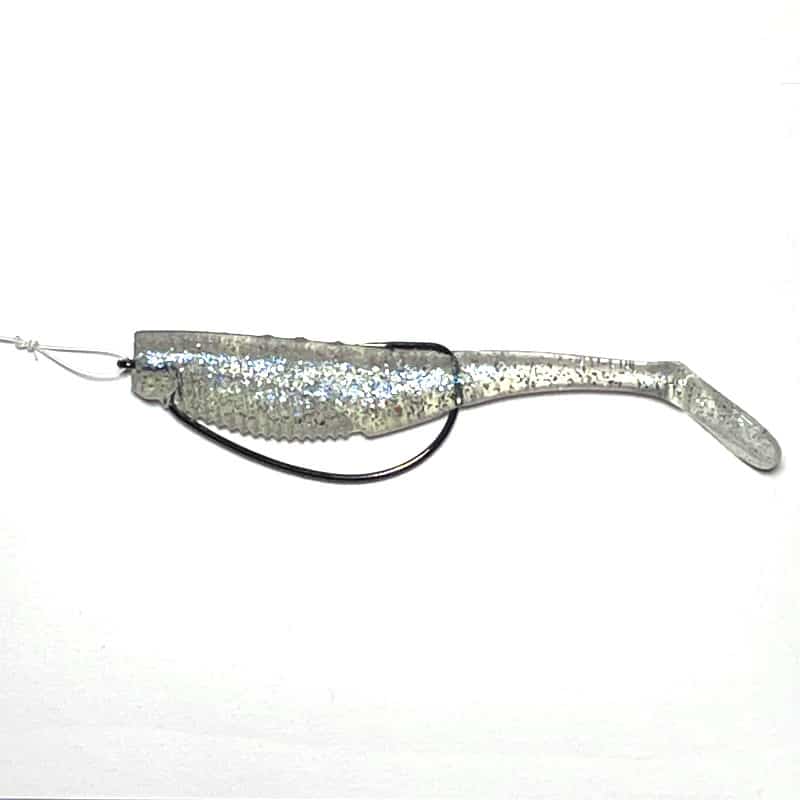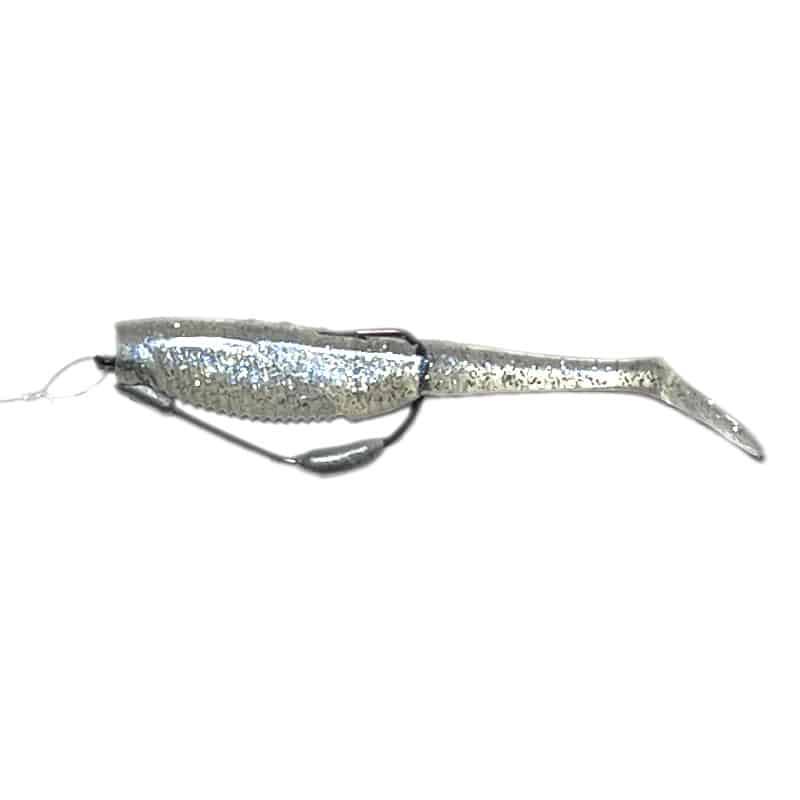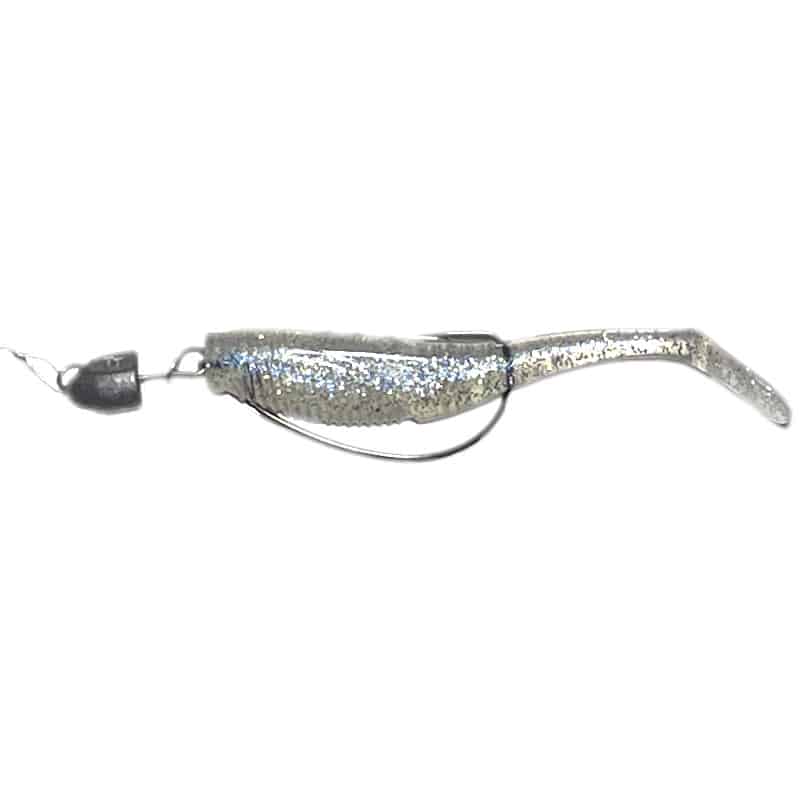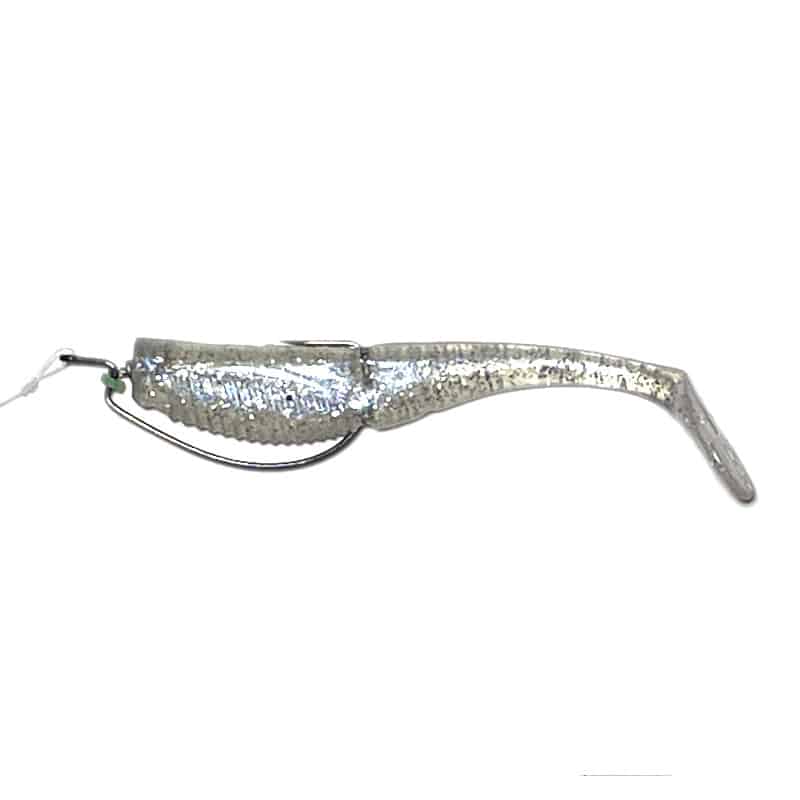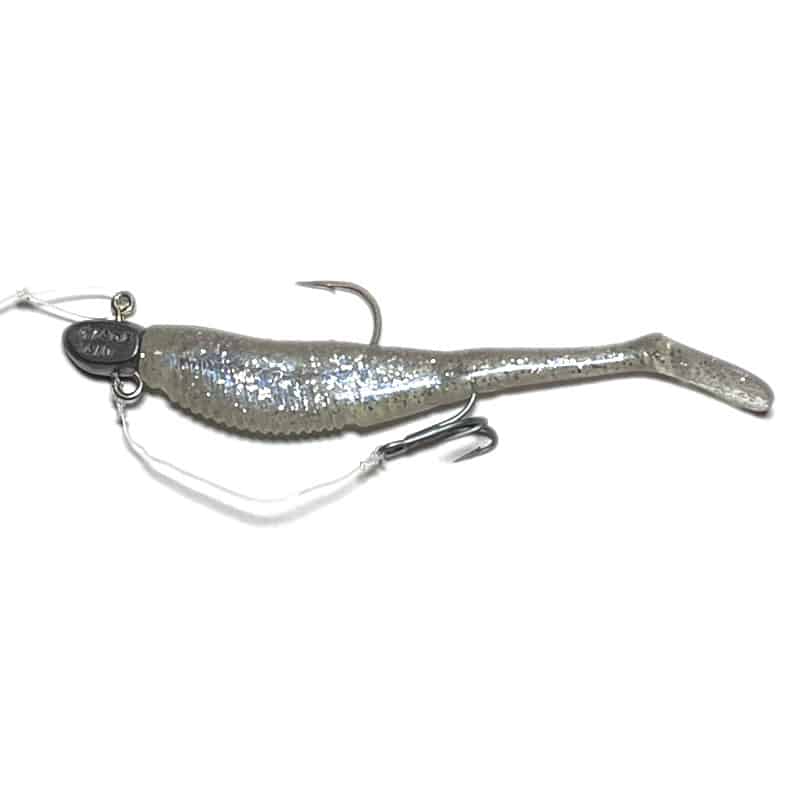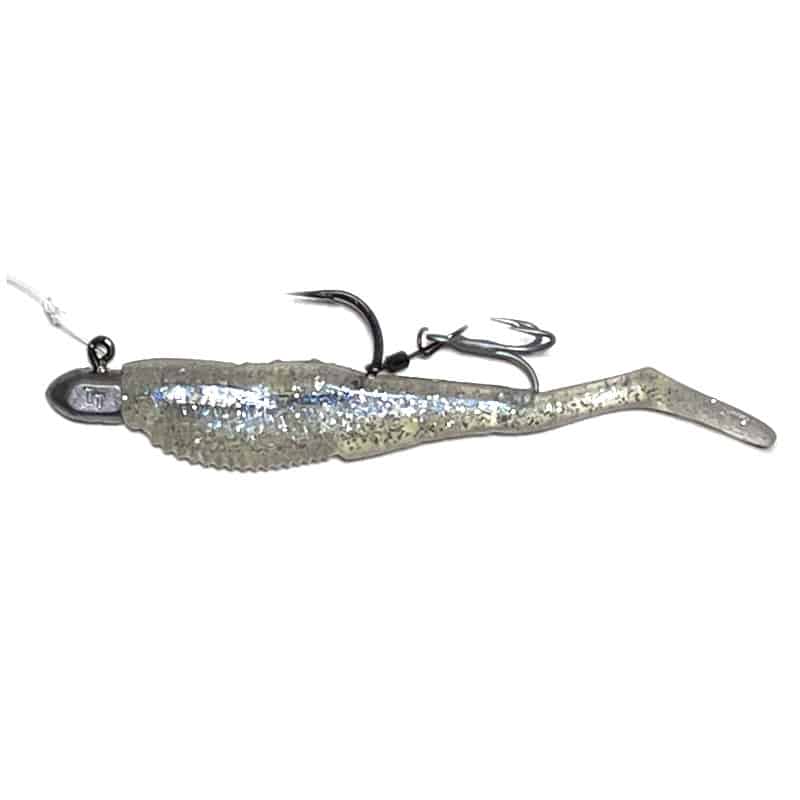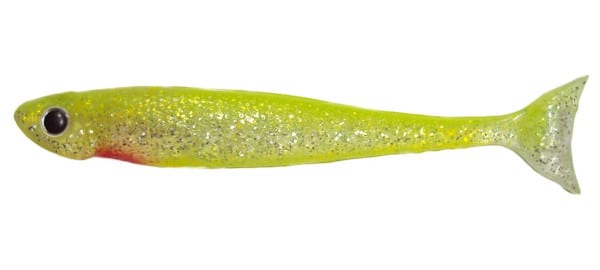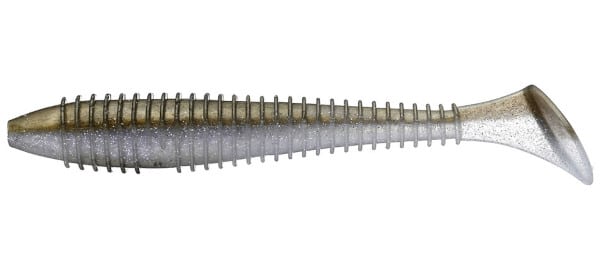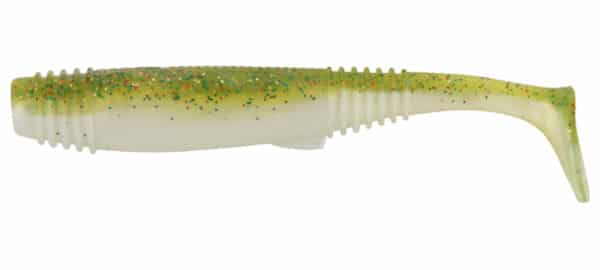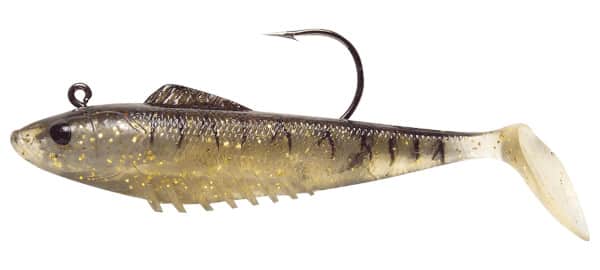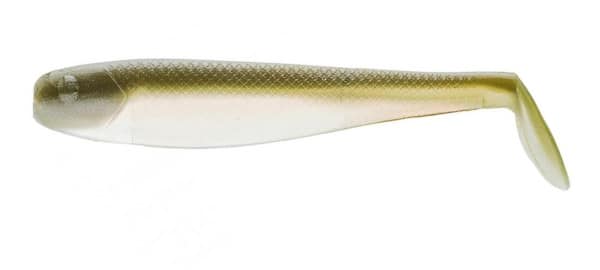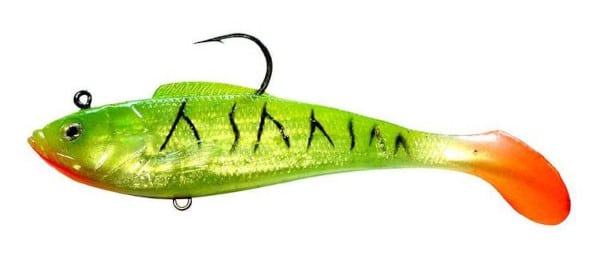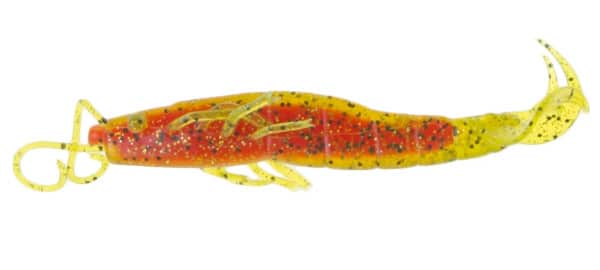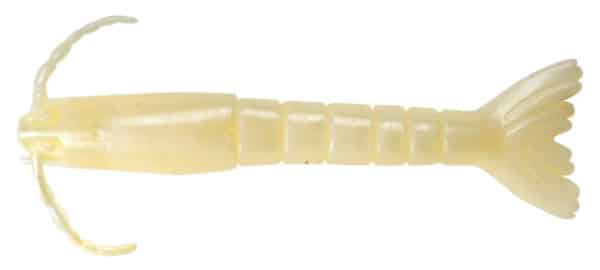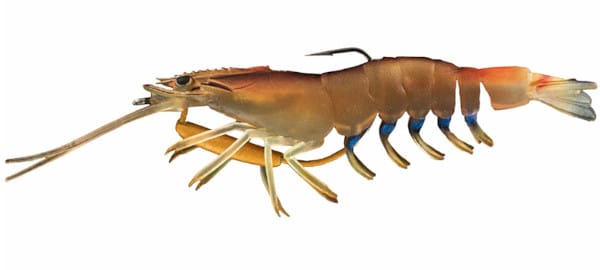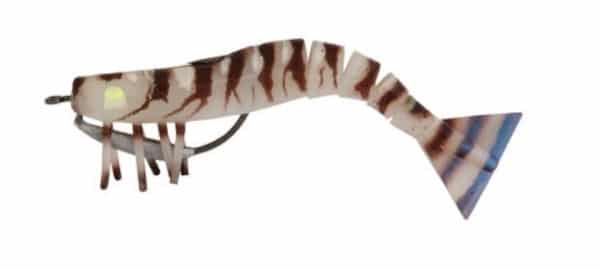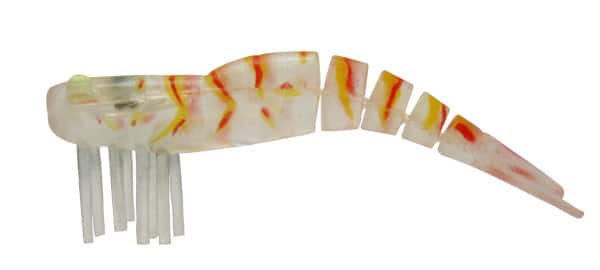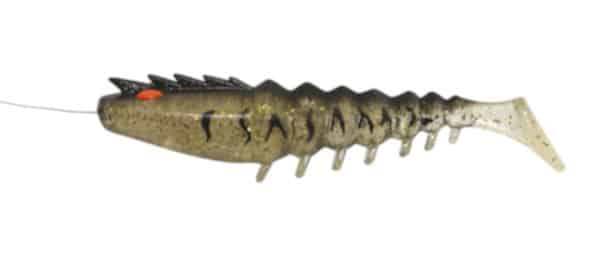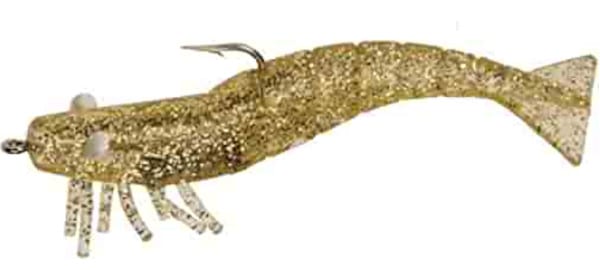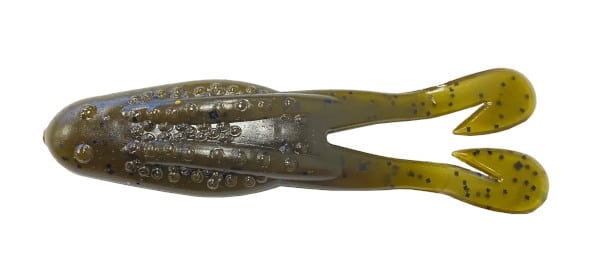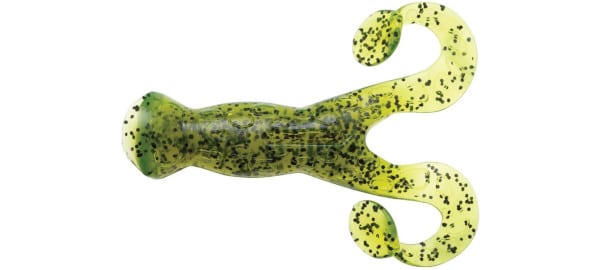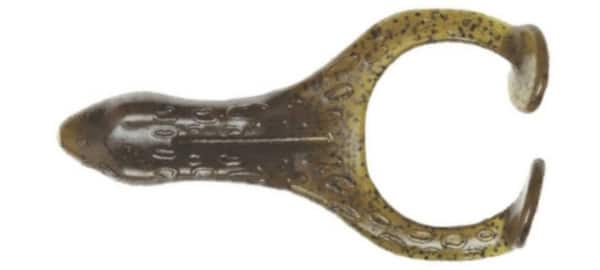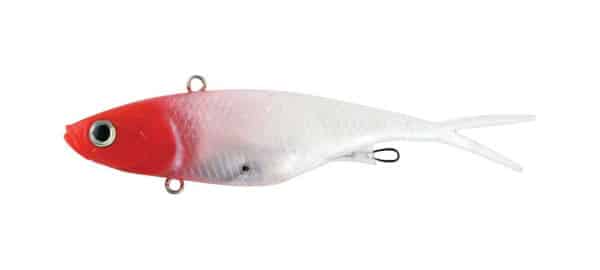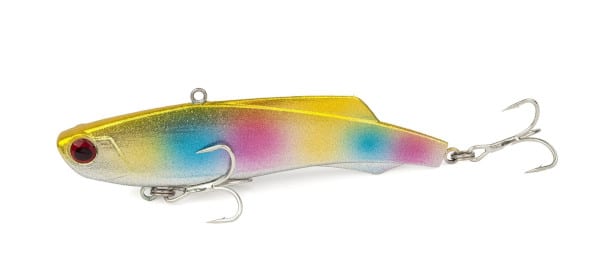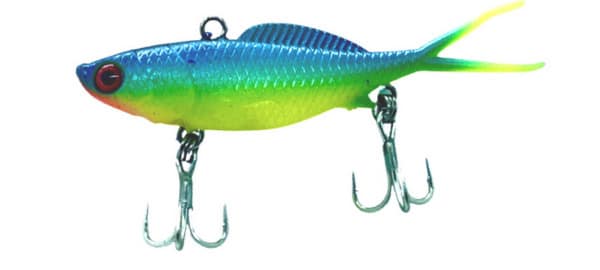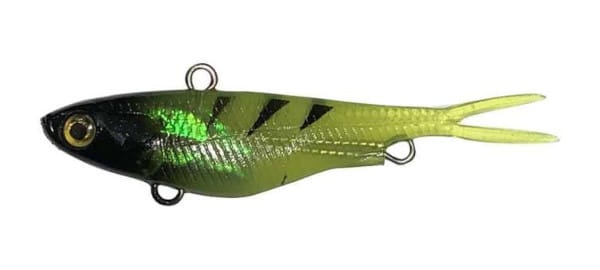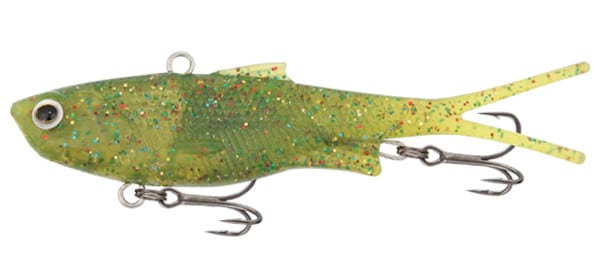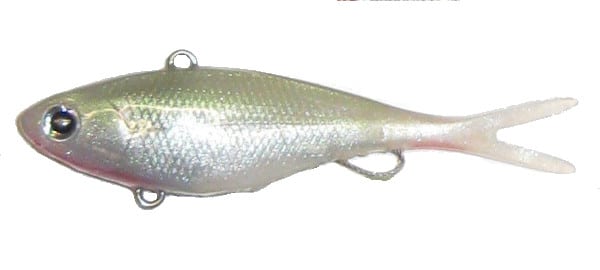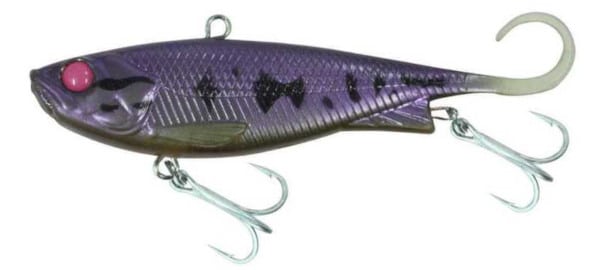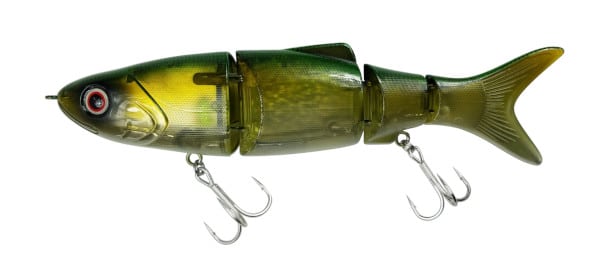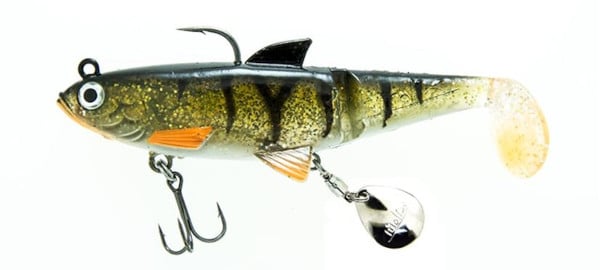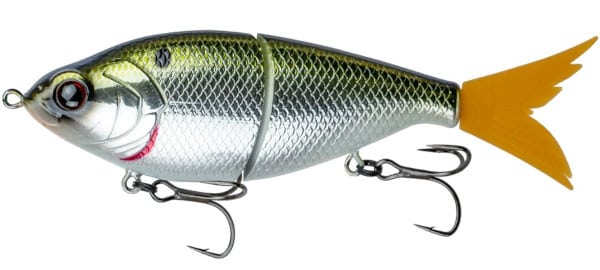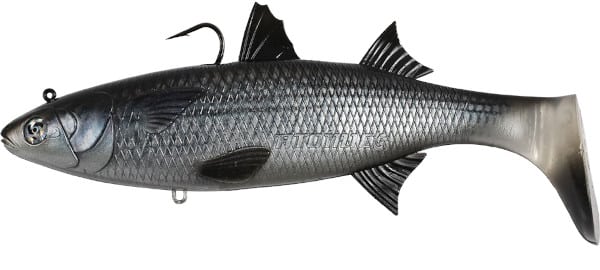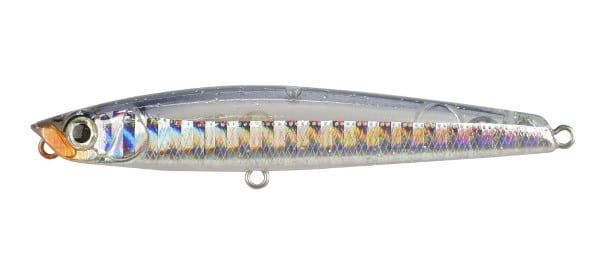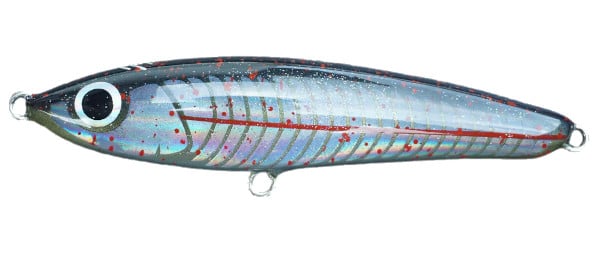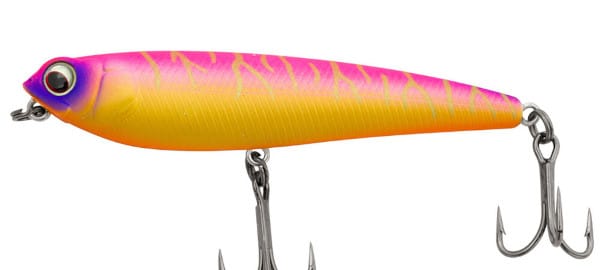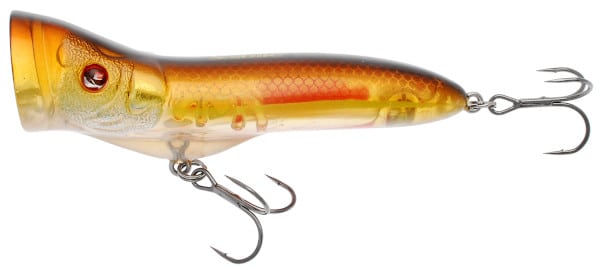Doc’s Ultimate Guide To Barramundi Lures And Techniques With 20 Killer Pro Tips
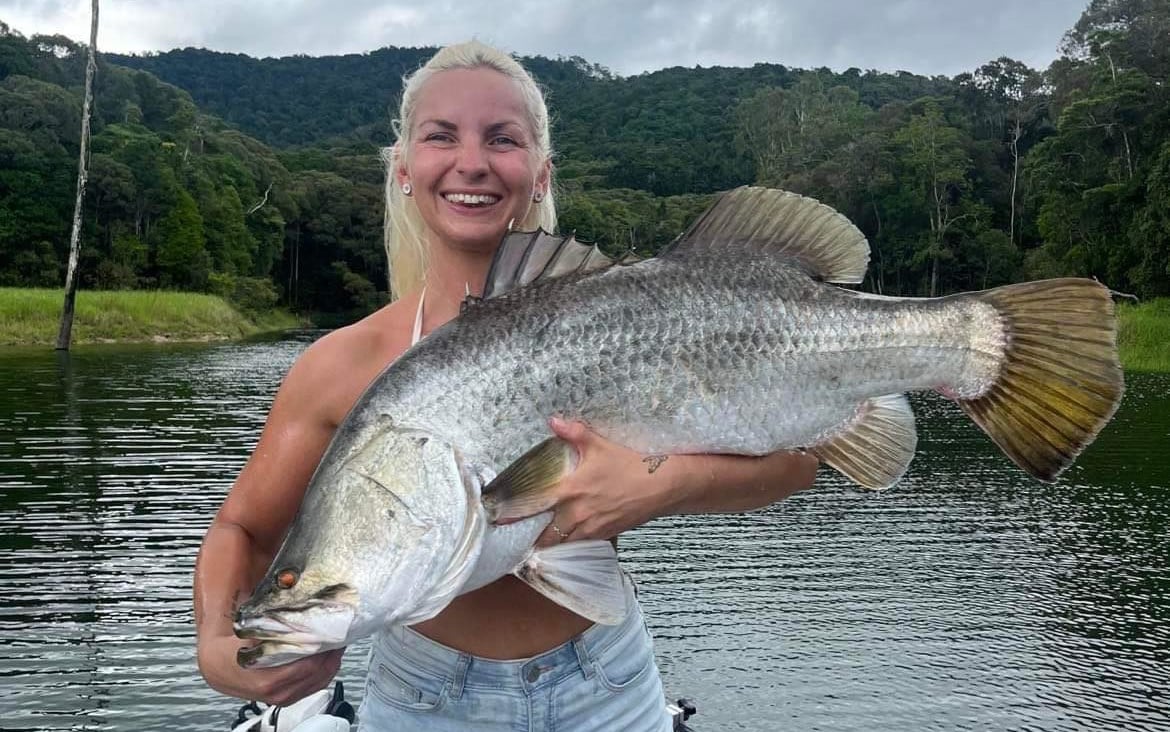
Topwater barramundi lures account for some big fish in shallow water. Sophie Price took this quality barra from Lake Tinaroo on charter with Tropic Barra Adventures
Australia is fortunate to have many iconic sportfish, but the mighty barramundi must be one of the most revered!
For residents of northern Australia chasing barra isn’t just a weekend activity. It’s a religion.
But the attraction isn’t limited to northerners. The quest to catch a barramundi lures tons of anglers from the southern states to our northern waterways every year.
As host of the Australian Lure Fishing Podcast I’ve had the privilege of interviewing dozens of top barra fishos. And I’ve learned a ton from their collective wisdom.
So, I’ve summarised my key learnings about barramundi lures, tackle and techniques into this handy barra fishing guide. Enjoy!
Here’s What We’ll Cover:
Section 1: Barramundi Lures
An A-Z of all the lure styles used ALF Podcast guests, with details of when where and how to use them.
A breakdown of how to choose the best barra rod and reel combos to fish the lures above.
20 top barramundi fishing tips pulled from all of my interviews with top barra anglers.
Section 1: Barramundi Lures
Back in the good old days we’d start by choosing what I thought was the best rod and reel combo for barramundi. Then I’d think about what barra lures to use.
Times have changed! These days it’s less about whether a particular combo can handle the fish and more about whether it can work the lures. In other words, now we match the tackle to the lures.
So with that in mind, I’ll start this discussion by focussing on the lures. Then I’ll move on to barramundi rod and reel combos to bring those lures to life.
The variety of barramundi lures on the market today is bewildering – and most of them can work at times……. Though at other times nothing seems to work!
Luckily, you don’t need to mortgage the farm and invest it all in every lure under the sun. You just need a good selection of lures that you can fish with confidence.
When I summarised the lure recommendations of my ALF barramundi guests into a Barra Tackle Cheat Sheet I made an interesting observation. No fewer than eleven different paddletail soft plastics and eight different soft prawns had been recommended. Not counting the different sizes and colours in each!
Thoughts on putting together a basic barra lure selection
In the case of the paddletails, they’re all similar, and yet they’re different. They vary in their sink rates, body roll, tail wiggle and so on. Some perform slightly better in some situations and others perform better in a different scenario.
But you still don’t need all eleven different paddletails and eight different prawns to catch fish. If a paddletail is the right lure on the day then it’s likely that several of the paddletail models suggested by ALF guests will work.
A skilled angler might prefer one model above all others but could probably make several of them work in a pinch. On the other hand, a novice could have the perfect lure for the job but not have the skills to catch a fish on it.
Limiting yourself to a smaller number of lures means you will learn to use those lures really well. Sometimes I think anglers have too many choices! Rather than learn how to use each lure in multiple scenarios, we just switch lures – and don’t know how to fish any of them properly.
Anyway, unless you own a tackle store you can’t have a lure for every scenario. No matter how many lures you own, every now and then you’ll find yourself wishing you had something different. That’s barra fishing!
Need help choosing barramundi lures?
The best advice I can give is to study ALF show notes for the areas you expect to fish and be guided by what my guests suggest. Once again, my tackle cheat sheet could help. Or you could take advantage of the ALF lure selection tool to help narrow down the field and create a shopping list!
Barramundi Lure Styles By Environment
Ten different styles of barramundi lures have been mentioned over the course of all my ALF podcast interviews and we’ll go through each of them shortly. They are:
Hard Bodied Barramundi Lures
Hard bodied, diving minnows are some of the most productive barramundi lures you’ll ever own.
The swimming action and vibration created by a hard body can at times bring fish from a long way off. Plus, this style of lure has plenty of hook points to get a hold in the bucket mouth of a barra!
There’s plenty to consider with hard bodied barramundi lures, one size definitely doesn’t fit all! But there are some common questions that apply to all hard bodied lures, which I’ve addressed below.
What size should my barra lures be?
Elephants eat peanuts, what do barra eat?
The saying “elephants eat peanuts” comes up a fair bit in barra chats on the ALF podcast.
Don’t feel that you always need to use massive lures, even for big barra. Relatively small (75-100mm) offerings regularly take metre plus fish. In fact, they’ll often catch fish when larger lures get refused.
That said, in some Northern Territory systems it can be productive to fish lures up to 180mm at times. The best advice is to find a past ALF episode about the location you’re planning to fish and then check out the lures that get recommend for that waterway!
What's the best lure action for barra?
The right wobble gets more gobble.
You’ll hear plenty of chatter about the need for a wide, rolling body action in hardbody lures for barramundi.
Wide bodies and wide bibs on fairly buoyant lures tend to result in a rolling wobble. So if that’swhat to look for if that’s what you’re after. They definitely catch plenty of barra.
As always though, it’s “horses for courses”. Shorter bibbed, suspending lures that are worked more erratically with lots of pauses can be deadly too. You’ll hear more about these shortly when we get into the lure styles.
Bottom line: there’s no all-round lure style or action. Sometimes subtle differences can dramatically change results, so it’s important to mix it up a bit to see what’s working.
Are the hooks and rings on my lures ok?
It depends - How badly do you want to stay connected?
If you’re not sure then the answer is probably “no”!
Barra are incredibly adept and destroying cheap hooks and making a getaway. And some tackle companies save a buck by using cheap hooks and rings.
If you’re not 100% confident then upgrade hooks and rings before you lose a fish. The majority of home-grown Aussie barramundi lures come fitted with super strong hooks and rings. And many high quality imports are pretty good, too. But still check!
Unfortunately, even high quality lures that made for less grueling species come with hooks and rings that aren’t barra friendly. You’ll definitely want to switch them out, taking care not to spoil the lure action with heavy hooks and rings.
It’s not a bad strategy to use a digital scale to check that you’re replacing hook and rings with ones of a similar weight. That might mean buying high quality, super strong fine wire hooks. Or you may need to drop down a hook size if thicker wire is used.
Should my barramundi lures be noisy?
Noisy lures can both attract and repel fish....
It’s worth having some noisy, rattling hard body styles in your collection. It’s also worth some that don’t have internal rattles.
Noisy lures come into their own when the fish are aggressive and especially when the water is dirty or the light is low. Barra can easily locate lures even without noisy rattles, but a bit of noise can make their job that bit easier.
Hard bodied barra lures that don’t contain rattles make a little less noise but they’re still not silent. Hooks and rings create some clatter, thought it’s more subtle that rattles. These lures come into play when the water is clearer and the fish are spooky.
Of course, barra write their own rules, so if quiet lures aren’t working in clear water then try a rattling one – and vice versa. Mixing it up is the key to success.
What colour should my barra lures be?
Any colour will do, as long as the fish like it
Regular ALF podcast listeners know that I’m not too fussed about lure colours. More often than not the fish can’t see much colour anyway. You can find out more about that here in Episode 55 and Episode 56.
But that’s not to say there aren’t times when colour is important. Many ALF guests have notched up a lot more barra than me and swear by certain colours.
So, when I analyse what’s been shared on the show over the years it boils down to this……. Chrome gold, chartreuse, tiger lily, guns n roses and a selection of natural colours seem to be the most popular with the top barra fishers. Brighter colours for dirty water and low light, natural colours for other times.
How fast should barra lures float?
Floating, sinking or suspending barra lures?
Very buoyant lures are great in snaggy waters, especially when you’re trolling. Just give the lure a bit of slack line the instant you feel it contact structure, more often than not it will rise up and go straight over the snag.
The only problem with high floating lures is that barra often respond very aggressively to pauses in the retrieve. If you pause a floating lure it floats away from the fish, looking very unnatural as it does so.
That’s where suspending lures are fantastic because they can be kept stationary in the fishes face for quite a few seconds, which can be deadly. But suspending barra lures are more prone to snagging, too. It’s always a tradeoff!
Shallow Running, Hard Bodied Barra Lures
Barramundi have eyes on top of their head – so we know they’re adapted to taking food from above. Plus, they love getting into really shallow water to hunt.
That’s two very good reasons why hard bodies that get down to around 1.5m (or less) can often be very effective barramundi lures. They’re perfect for working across flats, around small creeks and drains or along weedbeds and snags in estuaries and lakes.
I find that they’re a little snag prone because of the relatively small bib and a tendency to run fairly horizontal. But they’re just too deadly, have a lure retriever handy and just start fishing them!
There’s a common thread among Australian Lure Fishing Podcast guests when it comes to fishing shallow running hard body lures. I’ve found they nearly always talk about working them erratically with jerks and twitches. Occasionally they’ll wind them back to the rod tip at constant speed, but not that often.
Medium Diving Barramundi Lures
Hard bodies that get down a little deeper, say 2-4m, are particularly useful. They’re great on rock bars, snags or drop-offs where a shallow runner might not get into “the zone” but a deep diver would be constantly ploughing into structure or the bottom.
I’ve found medium diving barra lures to be a little more snag resistant than most shallow divers. I’d still carry a snag retriever though.
Once again, the “barra twitch” style of retrieve seems to be best. Getting the lure working erratically with pulses, twitches and hops usually outfishes a slow roll. Every day is different though, and it’s worth experimenting with a variety of retrieves. Sometimes a more subtle action wins the day.
Deep Diving Barramundi Lures
Hard bodies that bomb the depths to 5-8m and beyond are among the best barramundi lures around. And they’re not limited to just just deep water applications, either.
The long diving bibs and head-down swimming attitude of these lures is important. The result is that the tail of the lure flips upwards when a rock or piece of timber is struck. This movement helps keep the hooks safe, making deep diving hard bodies can be very snag resistant.
I find deep diving barra lures to be effective when I crash them into rocks, timber and the bottom. But they’re also effective in lake systems or deeper holes in estuaries where other hard bodies can’t reach the fish.
The downside of a deep diving barra lure is the bib catching the air in flight, which reduces casting accuracy. Large diving bibs also create a fair bit of drag when the lure is used. As a result, you might need a faster action rod to work the lure properly.
Suspending Hard Bodied Barra Lures
This final group of hard bodied barramundi lures isn’t characterised so much by diving depth. Suspending hard bodies can be shallow, medium or deep running. Regardless of depth, they are designed to neither float nor sink when the angler stops retrieving.
The ability to leave your lure hanging motionless on the fish’s nose is super powerful. It takes willpower to pause a lure for 10, 15, 30 or even 60 seconds. But if you can master it, savage strikes usually occur when you start retrieving again.
I’ve noticed that the trick is to have just the right amount of slack line when you pause. Too much and your barra lure will get moved by wind or current and will look unnatural. Not enough and you’ll struggle to set the hook when a barra inhales the lure.
The amount of dissolved salt in the water and the water temperature affect lure buoyancy. A barra lure tuned to suspend in freshwater will slowly float in saltwater. One that suspends in saltwater will slowly sink in the fresh. So depending on where you’re fishing you’ll need to adjust the weight of your lures. Adding heavier or lighter terminal tackle or using some sticky weights is the best way to tune a suspending barramundi lure.
Soft Plastic Barramundi Lures
Soft plastic lures have been around for decades and their effectiveness as barramundi lures is beyond doubt.
As with the hard bodied lures, there’s a staggering array of softies on the market. The styles, sizes, shapes and colours are overwhelming. Not to mention the multiple ways many of them can be rigged and fished.
Despite that, I was a little surprised as collated the soft plastic barra lure recommendations of ALF guests. I found that lots of brands and models got a mention, but only three basic styles were used by the barramundi guns. Paddletails, soft prawns and frogs were the key styles that seem to get used.
Some of these lures come pre-rigged and ready to fish. But the majority require the angler to rig them up. I’ve shown some different rigging styles below for those just learning how to catch barramundi on soft plastics. Click on an image for more detail.
Rigging Soft Plastic Barramundi Lures
Standard Jighead Rig
Standard jig heads are one of the simplest and most effective ways to rig soft plastic lures for barramundi (or any species).
Jig heads offer excellent exposure of the hook point and barb, so the hookup rate is usually quite good. They also ride with the point upwards, so snag resistance is relatively good.
The size of hook you use is important. I like my hooks to protrude from the back of the lure about half way down the body. It’s important the don’t exit the lure in the thin tail section or the action will be impaired.
Putting too much weight on your lure will also spoil the action. So, as a general rule, choose the smallest size of head that you can get away with based on wind, current and water depth.
Standard Jighead Rig
Standard jig heads are one of the simplest and most effective ways to rig soft plastic lures for barramundi (or any species).
Jig heads offer excellent exposure of the hook point and barb, so the hookup rate is usually quite good. They also ride with the point upwards, so snag resistance is relatively good.
The size of hook you use is important. I like my hooks to protrude from the back of the lure about half way down the body. It’s important the don’t exit the lure in the thin tail section or the action will be impaired.
Putting too much weight on your lure will also spoil the action. So, as a general rule, choose the smallest size of head that you can get away with based on wind, current and water depth.
Weedless, Unweighted
Rigging barramundi lures weedless on extra-wide gape (EWG) “worm” hooks is a great way to increase their snag resistance.
EWG hooks are first threaded through the nose of the lure, then out at the chin, around 6-8mm back. They’re then twisted and fed back through so the point rides flush with the back of the lure.
Weedless rigged soft plastics can be safely cast into dense snags and will usually come through without getting hung up. The downside is that qwhen barra are your target you’ll miss a lot of bites. Many species impart a crushing bite on a lure, which exposes the hook. Not barra though. They inhale the lure whole, so the lure body doesn’t get crushed and the hook may not get exposed.
Weedless rigging is always a trade-off to get more bites. The low hook set rate is (hopefully) compensated by an increase in bites by fishing when other lures cant!
Belly-Weighted Weedless Rig
An EWG hook with lead molded onto the shank causes your weedless barra lures to sink horizontally. I love this for imitating prawns and baitfish in amongst weed and hard structure.
Weighted EWG hooks are available in tackle stores. But an alternative I often use is tungsten putty or lead wire, which I add to a standard EWG hook shank after rigging. This allows for quick changes in the amount or location of the weight.
The hook shown here is a TT Lures ChinlockZ jig head, which has an extra insert under the chin to stop the lure sliding down. Other brands may have wire screws, hooks or other holding devices. A spot of superglue or half a lumo bead can also be used to stop the plastic from slipping.
Head-Weighted Weedless
A number of companies make head weights that can be clipped on to standard EWG hooks. The one shown here is a TT Lures HeadlockZ weight, but they all work in much the same way. Having a selection of different sizes allows the angler to quickly switch between hooks and lures.
This style of weight makes the lure sink head-first. They’re very versatile and perfect for fluttering your soft plastic down a vertical bank or a pylon. They won’t skip as easily as a belly weighted lure does, but can be crawled through the thickest cover.
Sinker Weighted
A small ball sinker provides a simple but highly effective way to head-weight soft plastic barra lures. Simply tie a small ball sinker in the loop knot beneath the chin of your lure. It’s cheaper but every bit as effective as made for the job head weight and is fished in exactly the same way. Lures can be worked through the gnarliest of structure when rigged in this manner.
Twist-Lock Bait Screw

Have a closer look at the front of the lure and you’ll notice that the hook isn’t in the plastic. Instead, a small wire spring (like the one pictured here) has been screwed into the plastic to hold the hook. The hook is then turned and fed through the plastic in the usual manner when weedless rigging. A piece of lumo bead has been threaded onto the hook shank to stop the twist lock from sliding down the hook.
There are several advantages to rigging this way. For one, it moves the hook slightly forward, allowing you to use a larger hook if you need to. Or, if you stick with the same hook you have more room for a stinger. It also allows the angler to switch lures without damaging the front of the lure, an area that often gets torn by rerigging.
Also, if you’re rigging weighted worm hooks you don’t need to push the weight through the plastic. Again, this reduces damage to your soft plastic lures.
Twist locks are great for worm hooks whether they’re unweighted, weighted or you’re adding a head weight or sinker.
Stinger Rigged Jighead #1
Having a single hook in a soft plastic is a major drawback.
One of the reasons hard bodied barramundi lures are effective is the hookup rates. Barra have cavernous mouths and are lightning fast a spitting a lure without getting hooked. With 2 or 3 sets of trebles, hard bodies give hookup rates when a lure is struck.
The majority of soft plastics only have a single hook – and usually there are no points in the back half of the lure. Adding a stinger to your plastics significantly increases the changes of a solid hookup.
Most jig head manufacturers have one of two models like the one shown here. The eyelet on the underside of the lure makes it easy to rig up a stinger. In the image I’ve rigged up by tying a small but super strong treble hook to the jig head using abrasion resistant leader mono and clinch knots. Many anglers prefer to use crimps for this task, as it’s easier to get the right length of leader. Others use soft, multi-strand leader wire in place of mono. And at times you’ll see folks switch out the treble hook for a single instead (point facing downward).
Stinger Rigged Jighead #2

If there’s a chance that your stinger might slip off the main jig hook, you can add a lumo bead to the hook. This acts as a stopper to keep the stinger attached.
Soft Plastic Paddletails
Paddletail soft plastics have relatively cylindrical bodies with a flat tail jutting out at right angles to the body. The tail “beats” as the lure is dragged through the water, creating plenty of vibration.
Depending on lure design and how it’s been rigged, the body can also roll, adding to the vibration. Generally speaking, the larger and flatter the tail, the stronger the vibration. Smaller paddles create less vibration but can usually be worked faster. That said, the speed at which paddle tailed barramundi lures can be worked depends a lot on the design, how it’s rigged and the types of hooks and/or jig heads that are used. A lot depends on the angler’s skill in rigging the lure. Sloppy rigging impairs the balance of the lure and reduces working speeds.
There are as many ways of working paddletail plastics as there are lures on the market. More, in fact! A the one end it could be very slow and subtle twitches, jerks and hops. At the other extreme you might be burning the lure as fast as you can crank.
The best advice is to have a listen to what ALF guests have to say for the areas you’re fishing. And mix it up. What works one day doesn’t always work the next day, so experiment to avoid heading for a fishless day!
Soft Plastic Prawns
This style of soft plastic lure is deadly not only on barra, but almost every other river and estuary species in northern Australia. Everything eats a prawn!
A 75mm soft prawn can be a deadly barramundi lure for the upper reaches of rivers and in billabongs, waterholes and so on. A 100-125mm soft plastic prawn can be super effective in estuaries and on mudflats, beaches and headlands.
Much like the paddletails, the versatility of soft prawn barra lures comes from the rigging options. They can be rigged weedless or with an exposed barb, weighted or unweighted, depending on the circumstances. If you skipped the discussion on rigging paddletails it might be worth going back to read up on rigging techniques.
Soft prawns can be fished in the same ways as paddletails. But are mostly they’re used (as you’d expect) to imitate prawns. So, working them with hops and twitches plus plenty of pauses typically gives the best results. Think about how a prawn moves both when it’s relaxed and when it’s being hunted. Then mimic those movements as closely as you can. Trundle them through snags, twitch them along snake drains and hop them through rockbars and drop-offs.
You can get more info on fishing soft prawns here.
Soft Plastic Frogs
No discussion about lures for barramundi fishing would be complete without some discussion of soft plastic frogs.
So let’s kick off with a great tip on this type of lure…….. Soft frogs are as effective on saltwater barramundi as they are on the sweetwater fish! The reason for that is because barra aren’t always taking them as frogs!
Sure, a soft plastic frog worked with little hops and twitches around the shallows of a lake or billabong can be effective. Likewise, plopping the lure onto a lily pad and then casually flipping it off the edge can be deadly. Barra eat frogs, so imitating real frogs can be effective at times.
But the barra guns I talk to mostly use frogs to create reaction strikes. In other words, the barra is just seeing something whiz past and smashing it out of sheer instinct. A plastic frog burning across the water surface at full speed looks unnatural – no frog ever swam like that. But imitating a frog isn’t the objective.
That’s why saltwater barramundi can destroy plastic frogs fished in estuaries and coastal areas. Frogs are pretty uncommon in those environments, but it doesn’t matter.
Soft plastic frogs are mostly fished on the surface, rigged weedless on large EWG hooks. Apart from snag resistance, this makes for spectacular visual fishing. A large barra engulfing a lure worked past a weed tower or mangrove snag with a big, splashy “BOOF”? Heart stopping!
Vibration Baits As Barramundi Lures
“Soft vibes” and metal vibes both have an important place as barramundi lures. They have a completely different action, vibration and appearance to any other lure.
Vibes sink pretty fast, and are great in deeper and/or faster flowing water where other lures are ineffective. They’re usually cast beyond the fish and sunk to the bottom (or required depth). In flowing water it’s effective to cast the lure up current (or up and across).
Once at depth, vibes are worked back through the fish with a hop and drop technique. The “hops” are usually gentle lifts of the rod, just enough to make the lure vibrate. The “drops” are when the lure is allowed to sink between hops and that’s when most bites occur. Quick reactions are required to set the hook at any twitch of the line during the drop.
Whilst this technique is the main one used with this style of lure, vibes are very versatile. On occasion it can pay to burn a vibe across a flat. Slow rolling one through a creek mouth or ripping it through weed can also be effective at times. With care they can be used when you’re fishing for barramundi around snags. David Green’s Masterclass on barra fishing with soft vibes gives a good explanation of this.
Swimbaits For Barra Fishing
Swimbaits are usually thought of more as cod lollies than barramundi lures. But both hard bodied and soft plastic swimbaits have a definite place, mainly in impoundment barra fishing.
As a barramundi fisher, these are not lures you’ll use every day. For starters, they are only effective when conditions (and the fish suit). They have a hefty price tag so you’ll want to be very selective about where you throw them. You’ll also need some hefty tackle just to be able to cast and work big swimbaits properly. Throwing big, heavy lures on heavy tackle can be tiring and isn’t for everyone.
But all of that said, there are times when these lures will catch impoundment barramundi when nothing else is working. A good example is when barra are feeding on larger models of bony bream.
The technique for fishing multi-jointed swimbaits is usually pretty straight forward. They’re typically just worked at slow or medium, constant speed. Depth is the main consideration, with some swimbait models having the option to fit chin weights. They can be fished unweighted in shallower water or with increasing amounts of weight as the water gets deeper.
Topwater Barramundi Lures
Anyone who has spent time chasing barra is likely to have heard their signature “boof” at some stage. Boofing is a telltale noise that occurs when barra implode on food items from the water surface. When you’ve heard it once your pulse will rise whenever you hear it again. It gets the pulse racing every time.
In fact, the only thing better is when a barra boofs on a lure you are working across the surface! So I was quite surprised at how few of my podcast guests have mentioned topwater barramundi lures (other than soft frogs). In fact, only one fizzer, one stickbait and one popper even received a mention during all those interviews!
Now, I know a lot of great barra fishers who catch plenty of fish on small poppers, stickbaits and fizzers. So I suspect the data may have been skewed by the way I ask the question. “What are your three top lures”? Perhaps topwater barra lures don’t get used every day so they’re not often in the top three.
When to use topwater barramundi lures
When topwater lures are hot you’ll enjoy spectacular, unforgettable barra fishing. Topwater lures can be worked across flats, snake drains, creek mouths, beaches, shallow snags, weedbeds and plenty more.
They are mostly worked in short bursts with quite long pauses between. Barra tend to suspend beneath the stationary lure just waiting for the next movement and then -POW! Whatever style of topwater barra lure you’re using I reckon leaving just a little slack line when the lure is floating is a great move. Not enough that you can’t take it up with a small movement of the rod….. But enough that the lure floats more naturally and that it can get further into the fish’s mouth when it gets boofed.
Section 2: Best Barra Rod And Reel Combo’s
You’ll see lots of posts on social media where people are asking about the best barra rod and reel combo. Usually, they’re looking for a generic “all-round” outfit but as you’ve seen, there are lots of different lures. As a result, there’s no “one size fits all” when it comes to barra tackle.
So what’s needed depends on what lures you’ll be using, and where. The perfect rod for soft vibe style barramundi lures might be 7’ to 7’6” long, with a fast action rod. That’s because this lure style requires the angler to make the long lifts and drops with a relatively heavy lure.
To use hard bodies in small mangrove creeks, a better option would be a 6’6” medium taper rod. Can you fish a soft vibe on the shorter rod? Yes. And a crankbait on a longer, faster action rod? Also yes. But in both cases it will be more difficult to work the lures effectively.
In terms of reels, barramundi are powerful fighters that need to be controlled, but they don’t make searing runs. So massive line capacity isn’t usually important. Compact, lightweight reels with smooth, powerful drags are what’s usually required. These are not only efficient, they can be fished with all day without getting tiring.
Guidance for choosing the best barra rod and reel combo
- Fishing flats and beaches with minimal snags, rocks, pylons and other structures. Fish are generally smaller (to around 90cm) and often casting light lures long distances is required. A 7’ to 7’6″ long, 3-5 kg fast or medium fast action spinning rod and 3000 sized reel is usually suitable. This can be spooled with 10-15 lb braided line and a leader of 30-40lb fluorocarbon. The lack of snags and hard structure means most fish can be landed if they’re played sensibly.
- “Snag bashing” or trolling estuaries and small creeks. A shorter rod is useful when you’re in tight cover and a fast or medium fast action helps when working lures. A 5-8kg or 6-10kg line class 6’ baitcast rod with 200 size reel or a 6’6” long spin rod with 4000 size reel is fine. 30-40lb braided line and a 60-80lb (or more) abrasion resistant leader will stop most fish.
- On impoundments a 5-8kg 7’ spin rod with a 4000 size reel, 30lb braided line and 60-80lb mono or fluorocarbon leader will handle most fish and give the added casting distance required to achieve stealth.
- Choose fast action rods for barra lures that are heavier or require short-sharp jerking actions and medium to fast action rods where smoother movements of the lure or more shock absorption is required.
Section 3:
Twenty Pro Tips Catching Barra On Lures From ALF Guests
Tip #1: Be Extra Careful About Your Terminals
There's no point hooking a barra if you can't stay connected
The barramundi is a fish that can be incredibly tough on lures, hooks and rings. Their jaw is so strong that it exerts enourmous pressure when a treble hook pins both the top and bottom jaw at the same time. Weak hooks can be easily straightened or snapped simply by the barra forcibly opening its mouth
Unfortunately, many “barra lures” come with treble hooks and rings that are way too lightweight. Back in Episode 266 I talked at length about choosing the best hooks for your needs (whatever species you’re targeting). To summarise the info as it relates to barramundi lures….. I like some of the fine wire but super strong hooks on the market. I prefer wide gape, round bend, straight pointed hooks. These have the greatest chance of finding a place to get struck in a barramundi’s cavernous mouth.
Other people prefer wide gape, curved point trebles for barra because they tend to stay in the fish better. It’s a personal choice, but with barra I feel it’s harder to get hooked than to stay hooked. They’re lightning fast at inhaling and rejecting a lure, so I want everything in my favour for the hookup. And I’ll worry about staying connected afterwards.
Balancing barramundi lures
Hook set rates aside, the other important consideration is the balance of your barra lures. Upgrading your hooks and rings is something of a science and randomly switching them out can ruin lure action. Top barra anglers will go to the extent of using a digital scale to weigh hooks and rings. To preserve lure action they want replacement terminals to weight the same as the originals.
More advanced strategies include deliberately using different terminals to tweak lure performance. Sometimes there are advantages to using thicker, heavier hooks instead of fine wire versions. A lot of barramundi lures are improved by weighting them a little so they don’t float too high in the water. Or even making floating lures suspend. This can be done with heavier hooks or sticky weights, or a combination of both.
And whilst you’re upgrading hooks it’s not a bad idea to make sure your split rings are up to the task also. If you’re not 100% certain about the strength of the rings on your barra lures, change them to good quality, super strong ones. It’s not worth risking the fish of a lifetime over two cents worth of split rings.
Tip #2: Colour Changes Are Always Worth A Cast Or Two
There isn't much that screams "barra" louder!
Barra are wonderfully adapted for hunting in low light and dirty water conditions. In fact, they actively seek out situations that give them the opportunity to use those adaptations to their advantage. The best barra fishing rarely happens when the entire water mass is clear, nor where the entire water mass is dirty. Colour change is often the key.
In rivers and estuaries, the places where dark, tannin coloured water from wetlands drains into a clear or turbid estuary. Just as exciting are places where wind and tides have created a line of muddy water along a shoreline. Or where clear oceanic water pushes up on the tide and mixes with dirty fresh or estuarine water.
In lakes I’d be casting my barra lures anywhere the wind has created a mudline that extends out from the waters edge. It doesn’t have to extend far, even just a foot or two.
Along the coastline I’d be putting my barra lures in places where wind and currents push dirty water across a headland or along a beach. Often there’s a patch of cleaner water on the lee side.
Barra love to hunt in all of these areas where colour changes happen. Their highly attuned senses allow them to ambush baitfish and prawns that don’t see them coming.
Tip #3: Barramundi Fishing Isn't Always About "Snag Bashing"
These fish use all parts of the water bodies they live in, not just timber
It’s a common barra fishing strategy to put a boat in the water and simply hop from snag to snag. Each snag gets peppered with a dozen barra lures until either a fish gets caught or the angler moves on! If that’s you’re approach, you’ll definitely catch the odd barra.
The problem is, it’s not always successful and lots of anglers don’t know any other way to fish for barra.
Barramundi use every bit of their habitat. So, if snag bashing is your only strategy you’re missing a lot of opportunities. It’s kind of like being a cricket batsman who only really has one or two shots. He has to watch a lot of hitable balls go by just waiting for the one he knows how to play. The more shots he can play, the more balls he can hit.
Likewise, the more ways you learn how to catch a barramundi the more success you’ll enjoy.
Pro Tip For Finding Barra
Like most fish, barramundi don’t feed 24/7. I’ve seen scenarios where they’re actively feeding on a mudflat before resting up in snags to digest their meal. So the snag bashers are casting to resting fish with a belly full of food! Smart anglers might instead have targeted them on the flats when they were actively feeding.
Remember that whether in an estuary, river, lake or inshore habitat, barra make it their business to know where to get a feed with minimal effort. They’ll sit out of the current and out of sight, but within easy reach of baitfish or prawns swept along by the current. Sometimes that will be a snag, other times it will be a weedbed, undercut, thermocline, rockbar, eddy, pressure edge, colour change, shadow line or other feature.
As a barra angler, your job is to figure out which features to fish on a given day, so it’s important not to become too obsessed with the snags.
Tip #4: Water Temperatures Drive Barramundi Behaviour
Like all animals, barra crave comfort. And that determines where they position themselves
For many years barramundi fishing was considered to be a summer time only pursuit. They love warm water, after all, they’re a northern species!
But it’s a big mistake to think that the hotter water, the better. Certainly not in the summer months.
Barra thrive when water temperatures are between 20-30 C. In aquaculture their growth rates have been noted to fall when the temperature falls below 25C or gets above 30C. Barra get heat-stressed, just like any other animal – and their only means of cooling off it moving into cooler water.
When the water is too warm for comfort barra take refuge by finding patches of cooler water. Shady areas, deeper holes or places where cool seawater comes in on the tide are all worth fishing. Barra can also get very active at night when surface water temps dip a little.
During winter, barramundi seek out patches of warmer water. In estuaries the sun can warm the dry sand at low tide, which in turn warms the water as the tide comes in. In lakes the shallow, windblown bays can receive an influx of slightly warmer water and are worth exploring.
Late afternoon is often the best time for winter barramundi fishing as the water has more opportunity to warm up throughout the day.
And remember, it only takes one or two degrees of temperature difference to have a dramatic effect.
Tip #5: Weedless Rigged Lures Can Cost Fish!
It's "Horses for Courses". Weedless isn't always best.
Weedless rigged soft plastics are among the best barramundi lures for working snags and weedbeds. They can be cast deep into the heaviest structure, and usually the lure can be retrieved without getting hung up. Getting into the heavy timber, rock or weed can mean more bites if that’s where the fish are feeding.
But the problem with weedless rigged barramundi lures is hookup rates.
It’s not such an issue when you’re fishing for some other species, such as mangrove jack. Jacks bite down hard on a baitfish to cripple and disable it. So when they hit a weedless soft plastic the point and barb get exposed.
But barra feed by implosion. They open their cavernous mouth super quickly and everything nearby gets sucked in with the huge rush of water. With no bite pressure there’s nothing to expose the hook. The lure is inside that big bucket mouth with a protected point.
Compare that with hard bodied barramundi lures. They will have six to nine exposed hook points inside the barra’s mouth and there’s a good chance one of them will pin the fish.
So as a rule of thumb, avoid rigging weedless lures for barramundi unless it’s necessary to do so. Consider fishing with an exposed barb any time you can get away with it, Just carry a lure retriever and be prepared to get snagged a little more often. The reward could well be more fish hooked.
Tip #6: Work The Tides To Catch More Barra
Tides determine when and where to throw your barra lures.
It’s cliché, I know. But the old saying “no run, no fun” is right on the money for barramundi fishing. Not just in saltwater systems, but flowing freshwater systems too.
Barra are powerful swimmers and not as lazy as people will tell you. But chasing down food takes a lot of energy and the more energy they use, the more food they need. So like all predators, conserving energy is one of the keys to survival.
Flowing water, whether if be tidal or freshwater runoff makes it easy for barra to know where food will be. When there’s no current the bait can move freely and will often disperse. A lot of energy can be expended just finding food. But as the current strengthens the bait seeks refuge in eddies and current breaks, conveniently concentrating them into schools.
Barra make it their business to find these little pockets of bait – and you should, too!
How to use tides to your advantage
Whilst at least some flow is important, really big tides can make for tough fishing. Strong currents can make lure placement difficult…… plus it can stir sediment and create very dirty water. Too dirty even for barra!
During really big tides the tide changes happen quickly and the periods of slower current are quite short. You need to be ready on the spot to get as many casts in as possible before the flow ramps up again. It’s not all bad though, often the bite can be frantic for that short time!
With a few exceptions, most tides are fishable in most locations, but you need to plan your trip accordingly. For example, if the last half of the runout tide is fishing well then start your day upstream and follow the tide down. This will extend the fishing window and allow you to be fishing the last half of the runout for hours.
Tip #7: It's Never Too Windy For Barramundi Fishing
Smart barra anglers look forward to windy days, especially on lakes!
Ok, before we go any further, let me qualify that statement……. As long as the conditions are safe for you and your boat it’s never too windy for barramundi fishing.
Most anglers hate the wind, but many fish species love it. So, if your aim is to enjoy a pleasant day on the water then choose a calm day. But if catching barra is your priority you’ll quickly learn to look forward to the windy days. Windy conditions bring the fish out to play and send the weekend anglers packing.
A bit of wind can be helpful when you’re throwing barramundi lures around estuaries and coastal areas. But does its best work in making impoundment fish easier to catch. Without wind lakes would have minimal water circulation (except around places where creeks flow in). A lack of current makes the fish are more scattered and less predictable.
The other other advantage of windy weather is stealth. With less boating traffic there’s less likelihood of some gumby spooking your fish! Often the weekend warriors who do stick around go looking for the sheltered areas. They might be lucky and find the odd barra, but it’s the opposite of where the fish will be most catchable. So you get the prime spots to yourself.
And when it’s windy the slap of waves on the shoreline and chop on the surface can mask noise that might spook fish. It’s still critical that you’re as quiet as possible, but you’ll get away with the odd mistake.
How to use wind in barramundi fishing
Few anglers realise how much water movement wind causes in lakes – or how important it is for barramundi fishing. Consistent wind coming from one direction for a few days creates persistent currents. And just like tidal currents and runoff in rivers, these currents help you to know where to cast your barra lures for the best chance they’ll get eaten.
Take a look at a map and think about what currents might have been created by the wind over the past few days. Look for areas where the wind strikes a bank, causing muddying of the water, accumulating food and oxygenating the shallows. On still days,check to see which way the wind was blowing in the days or weeks prior. The currents they create can continue for a day or two after the wind dies down.
Tip #8: Shed Some Light On The Barra? Or Throw Shade?
Does dim light always bring bright fishing?
Many species of fish feed a little more actively around dawn and dusk when the light is low. And through the hours of darkness, for that matter.
Barramundi even more so than most. They’re superbly adapted to low light, low visibility hunting and they love murky water. Ask any fisheries scientist that knows barra and they’ll share adaptations that cause them perfectly suited to low light.
If you’ve never done it, fishing for barramundi at night can be exhilarating. On a good night the chorus of loud “boofs” of feeding fish can heard all around. It’s not for everyone, and it has to be done with great care. It’s hard to see where you’re casting your barra lures, not to mention where navigational hazards might be. And if you’re fishing rivers or estuaries at night then crocs require even more respect.
Land based barramundi anglers often enjoy success where artificial lights on jetties, wharves and landings create “light pools”. Often there can be a distinct sharp edge separating the dark water from the illuminated areas. Barramundi can be found on the darker edges of the light pool, especially if there’s a pressure edge or current break too. They’ll also be found in the darkness under the wharf, jetty or pier you’re standing on.
Spotting The Opportunities
Barramundi love areas where their low light vision gives them the upper hand when ambushing their prey. But using low light to your advantage isn’t just about fishing at night.
Unlike humans, fish don’t have eyelids and their pupils don’t constrict. And barra have evolved with eyes that work in very low light. In fact, bright light causes them serious eye pain and their only relief is to move somewhere darker. That’s why on sunny days you’ll often find barra lurking anywhere there is a shadow. It might be around sunken timber, undercut banks, foam covered water, weed islands, under lillies and so on. They love areas where the light changes abruptly so they have that ambush opportunity.
Also be aware that on cloudy days you’ll often experience a flurry of activity just after the sun disappears behind a cloud. It can end just as abruptly when the sun breaks out again, though. Brodie Quaas explained this well in his interview about Lake Tinaroo Barra, as did Jase Wilhelm when we talked about Lake Monduran Barramundi. So respond quickly to take advantage of the opportunity.
Tip #9: The More You Understand Barramundi The More You'll Catch
Smart barra anglers look forward to windy days, especially on lakes!
It’s interesting watching people turn up at a lake or estuary for their annual fishing holiday. Often they head straight for the exact snag where they caught a barra last year. It’s as if “X” marks the spot.
But barramundi aren’t territorial and don’t live on one snag for their whole life. In fact, you know from reading this article that they don’t necessarily hang out on snags at all. So there must have been a reason that fish was there last year. Maybe it was the wind, tide, water temperature, thermocline, time of day, water level and baitfish. Maybe one or more of those is diffent this year.
The “X” marks the spot approach is a lazy one and relies on pure, dumb luck. It’s human to gravitate back to somewhere you’ve had success and there’s no harm side-scanning the area or casting a few barramundi lures at it. Just don’t get fixated on that spot.
Moving past “X marks the spot”
Consistency in fishing comes from understanding that the fish always position themselves according to the conditions. Barra move to follow bait species. They move to find comfortable water temperatures. Sometimes they’ll move to get out of bright sun, or to find cleaner/dirtier water. They’ll respond to conditions and shift to different parts of the system on different tides. They don’t stay in one place for long.
Like many predatory fish, barra also have places that they feed and places where they rest. They can be caught at either one, but you’ll need to adjust both the lures you cast and the techniques you use.
Anglers who take the time to understand the fish and respond to conditions often find barra movements quite predictable. So spend some time looking at maps, tide charts and wind before you get to your fishing spot. Once there, don’t be in a big hurry to start fishing. Doing some exploring and finding where the fish are and what they’re doing is a valuable use of your time. Think about where the fish may be, and why.
Tip #10: Elephants Eat Peanuts. Barramundi Lures Don't Have To Be Big
Some of the best barramundi lures are quite small compared for the size of fish they catch.
The barramundi has an enormous, cavernous mouth and can easily swallow very large food items. Anyone who’s spent a lot of time on northern estuaries will tell stories of 40cm diamond scale mullet getting “boofed” at times.
So, you might expect that barramundi lures would be large too. After all, even a small barra can easily inhale a 20cm hard bodied lure – and they do, at times.
Well, there are places where big barra lures are very successful. For example, really big hard bodies tend to work well in some Northern Territory systems, like the Mary River. And big, jointed swimbaits can be effective in some impoundments.
But based on ALF interviews, these seem to be the exception rather than the rule. Despite the fish’s ability to eat really big food items the most effective barramundi lures tend to be more modest in size, even for metre plus fish.
When it comes to hard bodies, soft plastics, topwater and stickbaits the most successful barra lures seem to be in the 80-130mm size range. Blades and soft vibes for barra fishing are usually around the 90-100mm size. That’s not to say you won’t catch fish on bigger lures, but certainly the consensus among my ALF interviewees has indicated a strong preference for smaller lures.
My Barra Tackle Cheat Sheet is a free download and summarises all the lures that my ALF podcast guests use for various situations. I’d definitely recommend checking it out!
Tip #11: Go With The Flow When Trolling Barramundi Lures
The advantages of trolling with the current outweigh the disadvantages
These days everyone seems to be fixated on casting lures for barramundi. For some reason, trolling seems to be looked down upon as a lazy fishing technique.
Sure, some fishers might just sling a barra lure out behind their boat and motor along hoping for a fish or two. But serious trolling that results in consistent catches is an art-form. It requires thought, skill and strategy, especially in tidal waters. Trolling in big systems can be a great way to cover water and find fish, even if you plan to stop and cast your lures once fish are found.
Tips for trolling barra
An important tip for those trolling estuaries is to work with the tidal currents. A barra lure trolled with the current can dive deeper and creates less drag on the rod. Plus, the boat will cover ground faster, so keep your eyes on the sidescan sonar until you find fish!
Most importantly though, trolling with the current presents your lures to the fish more naturally. Fish usually position themselves facing into the current to see food as it comes down. So your barra lure comes from in front of them, not behind. That’s also the direction that baitfish tend to travel, so your lures will look more natural.
Planning your fishing trip so that you run with the current one direction and then run back after the turn of the tide is smart. If you troll past a pod of fish or a likely piece of structure, simply cross the river and motor back upstream on the opposite side. Then make a second pass trolling with the current.
The downside of trolling with the current is that you’ll usually get snagged more often. You can’t simply drop your rod tip back and give your lure a little slack line to allow it to float over the snag. So have a good tackle retriever handy! And take solace from knowing that getting snagged means your barramundi lure is where it needs to be to catch fish.
Tip #12: Always Cast Beyond The Fish
Landing your barra lures too close to the target is a big mistake
Those just learning how to catch a barramundi often try to land their lure exactly where they expect a fish will be waiting. It may be a snag, a weedbed, a rockbar, pylon or simply a school of fish they’ve spotted on sidescan.
Putting your lure on the fish’s head can sometimes work if you’re using a topwater lure or shallow diver. But even then it’s not the best strategy. A much better approach is usually to cast well beyond the fish whenever you can. Then work the lure back past it. This avoids spooking fish as the lure splashes down too close.
Just as importantly, most barramundi lures don’t start working the instant you commence reeling. Casting past the fish enables the lure to get down to the required depth and be swimming properly when it reaches the barra. This is especially the case with deep diving lures.
Of course, there are times where you simply can’t cast beyond the fish. For example, when you’re fishing a snag tight against a deep bank. All you can do in this situation is choose lures that get to the required depth fast and try to land them on the water as lightly as you can.
Tip #13: Don't Get Obsessed With Sonar, It's Not Everything
Knowing how to use your sonar is critical but so is not being dependent
I remember when sidescan sonar first came to Australia and I rushed to get in line for one. These days most casual anglers have sidescan and few serious barra anglers would be without it.
To state the obvious it’s not enough to have sidescan fitted on your boat, you actually have to understand how to use it. It’s surprising how many people own the toys but have no idea how to use them. You need to know what your screen is telling you.
Also, keep in mind that sonar is just a tool that makes it easier to find fish, nothing more. Well, ok. The latest live sonar can tell you something of their movements and behaviours too. But it’s still just a tool.
I love sounder technology. And I’m blown away by how much we’ve learned about fish behaviour since the arrival of live sonar. But so much emphasis is put on electronics that a lot of anglers forget that nature is also giving tons of valuable clues.
Real magic happens when you know how to use your sonar AND combine that knowledge with a deep understanding of the fish and its environment.
Lots of barra anglers don’t get this, they think that sonar is everything. But I’ve noticed that every barra fishing gun that I’ve ever interviewed recognises this. Their powers of observation, their knowledge of barra and interpretation of the subtle hints that nature gives them are razor sharp. And that makes their sonar the more valuable.
Tip #14: Ye Olde Style Timber Lures Are Deadly On Barramundi
Most of the gurus have at least a few timber hard bodied barra lures in their kit
You could be forgiven if the idea of fishing with timber barra lures seems a little quaint.
Don’t be fooled. There are very good reasons why no serious barra angler should be without at least a few timber hard bodies in their kit. There are plenty of theories about why barra might sometimes prefer a timber lure over a plastic one.
I’m not sure anyone knows 100% why. But I can tell you that a lot of top gun barra dudes swear that on their day a timber hard body will leave a plastic one in it’s dust.
For what it’s worth, I believe that timber barramundi lures tend to have a slower action than plastic ones. Timber has natural inconsistencies, so the swimming action tends to be more erratic. And they make a different sound than plastic lures, too. Timber barra lures with internal rattles create a low pitch sound that travels further through water and is more natural to fish.
Whatever the reasons, timber lures definitely tend to get taken when the fishing is tough and slow. They are especially valuable in hard fished waters where the popular barramundi lures are familiar to the fish.
If you’re looking for some quality timber barramundi lures you might like to try Old Dog Lures, BTD Generals or Tilsan Barra’s
Tip #15: Stealth Is The Secret Weapon!
Spooked fish simply don't eat lures
Sound travels further and faster through water than it does through air. Which means barra usually hear your lure before they see it!
It also means that any unnatural sounds can spook them from a long way off. Dropped boat hatches, tackle, anchors and so on can all alert a barra to your presence. Once alerted they instantly become more cautious. I’d rather be casting at fish that have no clue I’m there, wouldn’t you?
Many ALF barramundi guests have talked about measures they take to reduce the noise they make. These include:
- Minimising electric motor use and keeping it to the slowest speed possible
- Anchoring or tying up, rather than spot locking
- Carpeting boat floors and taking care not to drop hatch covers
- Making long casts with the wind to get the lure as far away as possible
- Avoiding playing music and finding fish away from the boats and anglers
- Picking quiet times when there are less boats on the water. Even if it means missing the prime fishing times
Tip #16: Sticky Weights Are Worth More Than Gold
Quick lure modifications can make or break
Hard bodied barramundi lures have an awesome presence in the water. They create plenty of vibration, noise and commotion.
But sometimes you need them to float a little lower in the water. Sometimes you want them to suspend so when you stop working them for a moment they stay in the fish’s face. Or perhaps you even need them to sink.
I’ve already talked about using terminal tackle to acheive this, switching to a larger hook or a heavier wire for more weight. But the sticky weights you can buy in tackle shops can be even better. You can stick them onto the underside of your barra lures, and can later peel them off to be reused.
They’re quick to put on and take off, and they give you lots of options about how much weight you use, and where. If you don’t have any in your tackle box it might be time to grab a pack or two!
Tip #17: Leverage The Power Of Elimination
The fastest way to find what's working it to be methodical
We’ve covered a cross section of the barramundi lures suggested by ALF guests. But there are plenty more barra lures out there we haven’t discussed. Tons of them!
And have you noticed that each lure can often be fished in multiple ways, depending on conditions?
Well, here’s food for thought. Some techniques and actions will take barra on some days. And others on other days. You just need to figure out which. And once you figure it out, rinsing and repeating is often all you need to do.
A difference I see between my ALF guests and average angler is that my guests always have a method. They’ll have 3 rods rigged with different barramundi lures. They’ll pick on up and make 5 casts using a particular retrieve. Then five with a different retrieve. And maybe another five with a different retrieve again. Then they’ll switch rods and start over.
Approaching fishing methodically is a great way to eliminate what’s not working. Making random casts without much thought makes the process a lot more hit and miss. The faster you can get to what’s working, the sooner you’re onto fish!
Tip #18: Angling Is All About The Angles
Presenting your lure properly is a winning strategy
Ever wonder why fishing is often referred to as angling? Apparently, it comes down to an old English term where a hook was referred to as an angle. So, an angler is someone who catches fish on a hook. As opposed to a fisherman, who could also use a net, traps or other technique.
There ends the history lesson.
But I like the term “angler” for another reason. So much of what we do is about presenting our lures at the correct angle. A lure presented at the wrong angle might not get seen by a fish. Or worse, it could spook the fish.
Angles are as important in barra fishing as they were to the old English fly fisher. A lure that comes from behind a barramundi runs a high risk of spooking it. Either taking the fish by surprise or the line touching the fish’s back.
So before every single cast that you make, ask yourself which way the fish will be facing. And angle your lure appropriately whenever you can. That may require repositioning your boat, letting out a little extra anchor rope and so on.
Ideally, for best results, your lure should cross over in front of the fish. Or at least be swimming towards the barra’s face.
Tip #19: Use Attractant To Sweeten The Deal
It's one of the secrets for converting enquiries into bites
In situations where your barra lures are being worked slowly it doesn’t hurt to add a little attractant. Any time a lure is being worked gently the fish have ample time to inspect it. Time to inspect = time to reject! In other words, the fish has time to be put off if the lure seems unnatural.
Adding some attractant can help to make the lure seem more natural.
Of course, if you’re going for a reaction bite then attractant won’t help much. In that case the lure will be moving much faster, and the fish will lash out from instinct. But a slow-moving lure gives the attractant the opportunity to waft around near the lure.
It’s one of those small things that top anglers seem to do, but everyday anglers overlook.
Tip #20: Get Your Head Straight!
No one wants to be humiliated by a fish.....
It might be the final tip on this list, but that doesn’t mean it’s not one of the most important! Something that definitely sets my ALF guests apart from the average fishing punter is mindset.
Having confidence in yourself, your tackle and your technique is incredibly important. Watch the internal talk. “Tide’s not the best”. “I should’ve bought that other lure”. “Probably take me all day to get my casting dialed in”. “I never have much luck”.
Getting the best results means being on your game. That’s hard to do if you start the day by making excuses about why you’re going to fail.
Much better if you can focus on getting answers. “What’s the opportunity here?” “How will the fish respond to <xyz>?” “What haven’t I tried yet?” “What clues are the fish giving me?” “Why wouldn’t that lure get eaten?”
A professional sportsman would allow themselves to set foot on a field filled with doubt. They know that bad mindset can undermine even the best skills. Fishing can be the same.
Will mindset ever replace skills and experience? Nope. But low confidence will definitely result in poorer results, no matter what your starting skill level.

